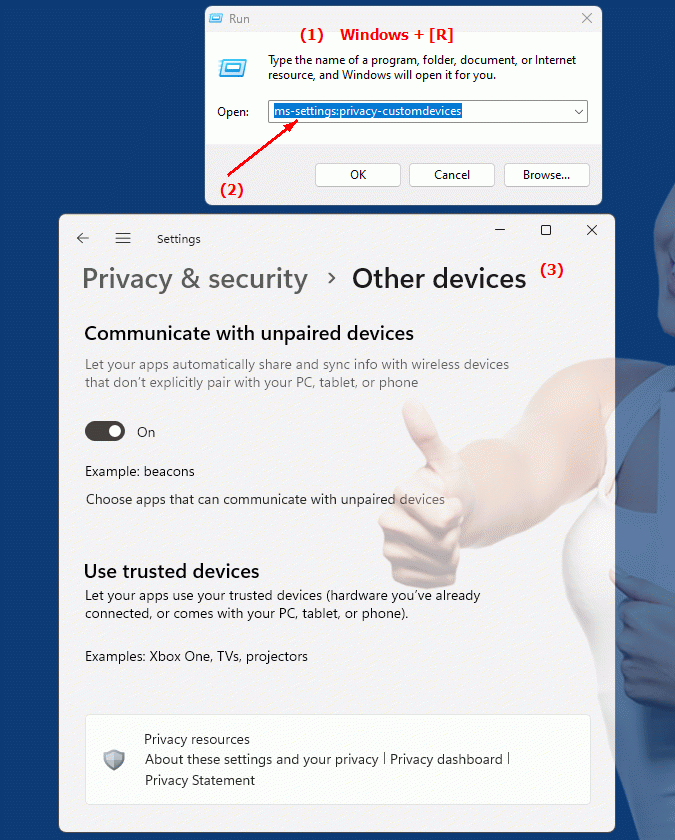The "ms-settings:privacy-cus tomdevices" URI in Windows 10 und 11 leads to the privacy settings for custom devices.
This feature allows users to control how Windows handles custom or external devices that may require specific privacy settings or permissions. This includes devices such as external sensors, special peripherals, and other custom hardware attached to the system.
1. ms-settings:privacy-customdevices
2. Availability under Windows
3. Other useful commands in the Windows settings
1. The Command ms-settings:privacy-customdevices
1. Press Windows R on your keyboard.2. Simply execute the following command: ms-settings:privacy-customdevices
(This command can also be used as a desktop shortcut.)
3. You can complete the operation by pressing OK or by pressing [Enter].
(... see Image-1 Point 1 to 3)
The settings described in Windows 10, 11 or 12 are now available to you. You can now access the options explained above in your Windows 10, 11 or 12.
This is how the problems and questions listed below are addressed.

1b. This is how the problems and questions listed below are addressed.
What settings can a user set in the Windows custom device privacy settings?How do I change the way Windows handles external sensors connected to the system?
What can a user configure in custom device privacy settings?
How do I ensure that specific peripherals have the required permissions and settings?
What options are available to improve privacy when interacting with custom devices?
How do I customize privacy settings for custom devices in Windows?
Which feature allows users to control contact with external sensors and set their privacy settings?
What are the steps to configure custom device privacy settings in Windows 10?
How do I change Windows' default settings for interacting with custom hardware?
What role do privacy settings play when integrating new custom devices into a Windows system?
2. Available in Windows 10, 11 and 12 along with the build numbers!
Availability in Windows versions
1.Windows10:
- Availability:
The "ms-settings:privacy-customdevices" URI is not available in Windows 10. Windows 10 provides basic privacy settings for general device settings, but custom device-specific options are not managed through a dedicated URI like "ms-settings:privacy-customdevices" in this release.
- Build Number:
Since this URI is not available in Windows 10, there is no specific build number that supports this feature.
2.Windows11:
- Availability:
In Windows 11, the URI "ms-settings:privacy-customdevices" is also not available. Windows 11 also provides basic privacy settings for devices, but a specific URI to manage privacy settings for custom devices does not exist.
- Build Number:
Since this URI is not available in Windows 11, there is no specific build number that supports this feature.
3.Windows12:
- Availability:
With Windows 12 expected to be released in 2024, there is currently no confirmed information on whether the "ms-settings:privacy-customdevices" URI will be available. Windows 12 could potentially offer enhanced privacy and device settings, but details on the availability of this specific URI are not yet confirmed.
- Build Number:
The exact build number for Windows 12 is not determined at the time of release, but information about specific URIs and their availability is expected to be provided when the first builds of Windows 12 are released.
Summary
The "ms-settings:privacy-customdevices" URI is not present in the currently available versions of Windows 10, 11, and 12. Windows 10 and Windows 11 provide general privacy settings for devices, but no specific options via this URI. The availability and details of the URI in Windows 12 are unclear at this time and may be announced with the release of the first builds of Windows 12.
